Photo / Video News & Reviews
Nauticam announce NA-Z7 for Nikon Z7 and Z6 Cameras

 The Z7 and Z6, Nikon’s first full-frame mirrorless cameras offer underwater shooters the same legendary Nikon image quality with the versatility of an electronic viewfinder and the more compact form factor of a mirrorless system. The Nauticam NA-Z7 housing supports both the Z6 and Z7 camera models.
The Z7 and Z6, Nikon’s first full-frame mirrorless cameras offer underwater shooters the same legendary Nikon image quality with the versatility of an electronic viewfinder and the more compact form factor of a mirrorless system. The Nauticam NA-Z7 housing supports both the Z6 and Z7 camera models.
The Nauticam NA-Z7 Housing
The NA-Z7 inherits all of the key innovative features from Nauticam DSLR systems scaled into a smaller form factor built around the Z6 and Z7 cameras. Best of all, it uses the same N120 Port System!
Z and F Mount Support
The Nauticam NA-Z7 housing allows not only the use of the new Z mount Nikon glass but also the legendary Nikon F mount lenses with the Nikon FTZ Adapter. The N120 port system allows all compatible Nikon F-mount lenses to be used, providing underwater photographers with a world class lineup of fisheye, ultra wide, mid-range, and macro lenses that can be used with the NA-Z7 housing. Existing Nauticam DSLR housing owners will be glad to know that all of their ports, viewfinders, and Nikon lens gears transition seamlessly to the NA-Z7 housing, and support will be added for the exciting new Z-mount lenses as they are released.
The Nauticam NA-Z7 housing features two lens release buttons that correspond to either F or Z mount lenses, allowing lens swaps without having to remove the camera from the housing. A vacuum system reset switch is located below the tray as well so there is no need to open the rear of the housing during lens or port changes.
Intelligent Control Placement
Nauticam engineers are obsessed with functionality and this is evident in the location of essential controls. Regardless of where the control is located on the camera, the Nauticam housing puts them where you need them to be underwater. For those switching between photo and video modes, an easily reachable switch is located on the right rear of the housing. The right side double thumb lever, easily reached from the right handle features access to the AF-on and Record buttons respectively. Between the double thumb lever and the multi-stage shutter release is an ISO lever allowing quick changes to sensitivity.
The left double thumb lever accesses the DISP and Playback controls. The Zoom In and Zoom Out controls, located on the right rear of the camera body is relocated to the left side of the housing to a location more familiar to Nauticam housing users.
The switch that allows for switching between the LCD display and the EVF, a crucial and much used control with mirrorless systems is located close to the left handle within easy reach.
Front and rear control dials are readily accessible by the familiar large knurled dials at the right handle. The ergonomic housing handles are rubberized and feature stainless steel stiffening brackets to ensure a stable platform when using large strobes or video lights attached to the pre-installed 1″ mounting balls.
The Nikon Z7 and Z6 Cameras
For many full-frame Nikon shooters the appeal of a mirrorless camera had been tempered by the though of having to invest in and master a new system by moving to another ecosystem such as Sony. For those awaiting a mirrorless system that utilized Nikon imaging technology and ergonomics, the wait is over. The Z6 and Z7 cameras feature an identical body, differing only in their feature sets, an ideal feature when it comes to housing the camera for underwater use.
Both camera bodies are built around the new Z-mount. With an incredibly wide 55mm mount diameter (17% larger than F-mount) and very short flange distance, the Z-mount is able to offer a maximum aperture of F0.95. While the current range of Z-mount lenses is limited, almost the entire line of F-mount lenses is usable with the optional FTZ Adapter. When using the adapter, even non VR lenses benefit from the camera’s in-body stabilization. VR and Z-Mount lenses receive 5-axis stabilization whereas non-VR F-mount lenses have access to 3-axis stabilization.
There is also a dedicated e-VR (electronic VR) that combines optical and electronic stabilization for video shooting. Both the Z6 and Z7 are able to capture internal UHD 4K at 30fps or 1080 HD at up to 120fps at 144 Mbps. Capture uses the full-width of the sensor and both cameras are capable of outputting 10-bit N-log UHD 4K over HDMI that supports start/stop control.
The OLED electronic viewfinder (EVF) of both the Z6 and Z7 gives 100% frame coverage at Quad-VGA (3.69M dot) resolution. When triggering external flashes, both cameras feature a 1/200 X-sync shutter speed.
Nikon Z7 Camera
The Z7 features a high resolution 45.7MP FX-format sensor that can shoot at up to 9FPS. The Z7 features a wide ISO range of 64-25,600. Autofocus is achieved with 493 on-sensor AF points that cover 90% of the frame and the camera intelligently switched between contrast-detection and phase-detection points to achieve accurate focus regardless of light conditions.
Nikon Z7 Key Camera Specifications
- 45.7MP FX Format Sensor with no OLPF
- 9 FPS continuous shooting
- 64-25,600 ISO Range
- UHD 4K 30p recording with no FOV crop
- 10bit UHD 4K N-log output via HDMI with start/stop support
- 5-axis VR stabilization (with Z lenses)
- 8K time lapse with exposure smoothing
- CF Express ready (currently supports XQD)
Nikon Z6 Camera
The Z6 is equipped with a 24.5MP FX-format sensor capable of up to 12FPS continuous shooting with an ISO range of 100-51,200. Video is recorded internally at up to UHD 4K 30p with no field-of-view crop. 273 on-sensor focus points cover 90% of the fame and the Z 6 intelligently switched between contrast-detection and phase-detection points to assure accurate autofocus.
Nikon Z6 Key Camera Specifications
- 24.5MP FX Format Sensor with OLPF
- 12 FPS continuous shooting
- 100-51,200 ISO Range
- UHD 4K 30p recording with no FOV crop
- 10bit N-log UHD 4K output via HDMI with start/stop support
- 5-axis VR stabilization (with Z-mount lenses)
- 4K time lapse
- CF Express ready (currently XQD only)
Flash Triggering
The NA-Z7 comes with Nauticam’s self powered manual flash trigger preinstalled. The flash trigger plugs into the hot-shoe of the camera and uses LED lights recessed into each of the two optical bulkheads to trigger supported underwater flashes when used with the correct fiber optic connection. The flash trigger is powered by coin cell batteries that provide thousands of flashes per battery. The flash trigger can be upgraded to support TTL triggering (PN 2638 TTL Converter for Nikon).
Key Features
Patented Port Locking System
Unveiled on the very first Nauticam DSLR housing in 2009, this locking lever has become a signature of the Nauticam brand. No twisting or threading action is required to mount a port, and it locks securely in place with this lever. Nauticam also offers locking port extensions, meaning a dome will never twist, even when used with a long extension ring.
Housing Locking Latches
The industry’s easiest to use housing closure system, requiring very little hand strength to operate, secures the housing back in place. The latches are safely locked to prevent accidental opening, but are easy to open when needed for a quick battery or memory card change
HDMI Output Support
The Z7 camera supports 10 bit HDMI video output at UHD resolution (3840 x 2160) at up to 30p. An external monitor or recorder can be used with the optional standard M16 HDMI bulkhead (PN 25033), HDMI (D-C) cable in 190mm length (PN 25036) which come standard in any Nauticam monitor housing package.
What’s Included
- Nauticam NA-Z7 Housing
- 90122 Housing O-ring, lubricant and removal tool
- 25625 M16 Vacuum Valve II (pre-installed)
- CR2032 Battery (for vacuum system)
- Allen Wrench Set
NA-Z7 Recommended Accessories
- 25625 M16 Vacuum Valve II (Pushbutton Release)
- 32201 Nauticam 180 straight viewfinder
- 32203 Nauticam 45 viewfinder
- 26308 TTL Converter for Nikon
- 85201 0.36x Wide Angle Conversion Port with Aluminum Float Collar (incl. N120 to N100 port adaptor)
- 86201 Macro to Wide Angle Lens 1 (MWL-1) 150 deg. FOV with full frame 60mm macro lens
- Various electrical bulkheads
- 25033 standard HDMI bulkhead with M16 thread
- 25036 HDMI (D-C) cable in 190mm length
- (Both 25033 and 25036 are standard accessories in Nauticam monitor housing)
NA-Z7 Details and Specifications
- Depth Rating: 100m
- Weight: 3.02 kg
- Dimensions: 360mm(W) x 200mm(H) x 160mm(D)
- Battery for Vacuum system: CR2032
For more information visit the Nauticam websites:
UK: Click here
USA: Click here
Blogs
Diver Discovering Whale Skeletons Beneath Ice Judged World’s Best Underwater Photograph
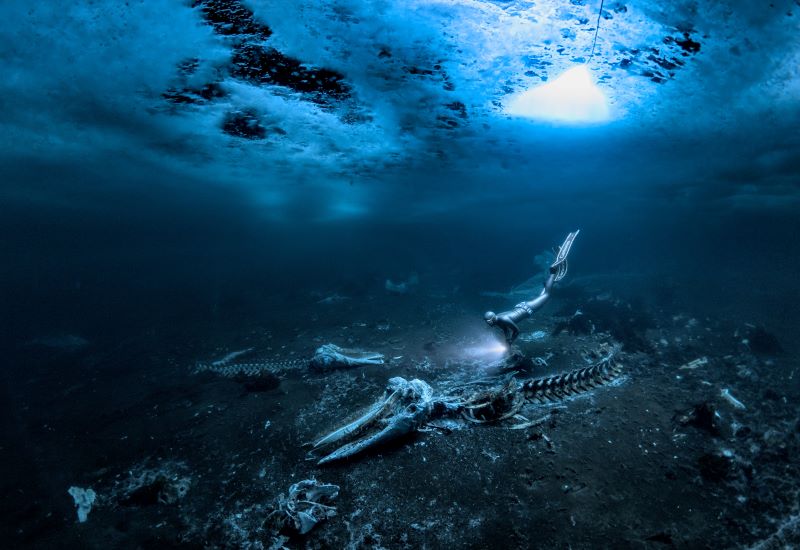
An emotive photograph showing a freediver examining the aftermath of whaling sees
Alex Dawson from Sweden named Underwater Photographer of the Year 2024. Dawson’s
photograph ‘Whale Bones’ triumphed over 6500 underwater pictures entered by underwater
photographers from around the world.
“Whale Bones was photographed in the toughest conditions,” explains chair of judging
panel Alex Mustard, “as a breath-hold diver descends below the Greenland ice sheet to bear
witness to the carcasses. The composition invites us to consider our impact on the great
creatures of this planet. Since the rise of humans, wild animals have declined by 85%. Today,
just 4% of mammals are wildlife, the remaining 96% are humans and our livestock. Our way
needs to change to find a balance with nature.”
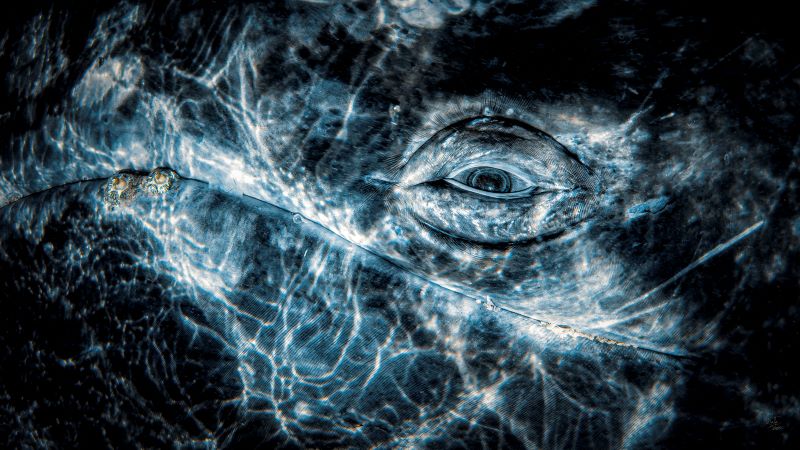
Photo: Rafael
Fernandez Caballero
Whales dominated the winning pictures this year with Spanish photographer Rafael
Fernandez Caballero winning two categories with his revealing photos of these ocean giants:
a close up of a grey whale’s eye and an action shot of a Bryde’s whale engulfing an entire bait
ball, both taken in Magdalena Bay, Baja California, Mexico. Fernandez Caballero took ‘Grey
Whale Connection’ while drifting in a small boat, holding his camera over the side in the water
to photograph the curious whale. ‘The End Of A Baitball’ required Fernandez Caballero to dive
down and be in exactly the right place at the moment the whale lunged. “The photo shows
the high speed attack,” he said, “with the whale engulfing hundreds of kilograms of sardines
in one bite — simply unforgettable to see predation on such a scale.”
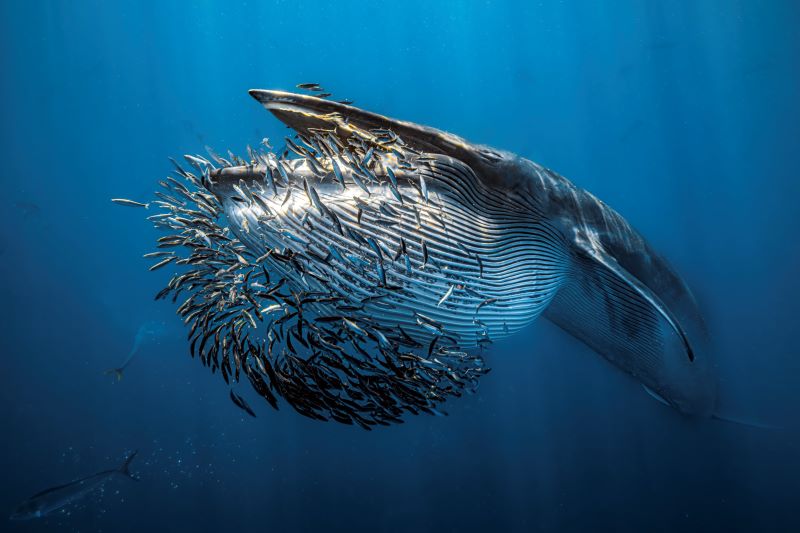
Photo: Rafael
Fernandez Caballero
Lisa Stengel from the United States was named Up & Coming Underwater Photographer of the Year 2024 for her image of a mahi-mahi catching a sardine, in Mexico. Stengel used both a very fast shutter speed and her hearing to catch the moment. “If you listen there’s an enormous amount of sound in the ocean,” she explained. “The action was too fast to see, so I honed in on the sound of the attacks with my camera to capture this special moment.”
“It is such an exciting time in underwater photography because photographers are capturing such amazing new images, by visiting new locations and using the latest cameras,”
commented judge Alex Mustard. “Until this year I’d hardly ever see a photo of a mahi mahi,
now Lisa has photographed one hunting, action that plays out in the blink of an eye.”
The Underwater Photographer of the Year contest is based in the UK, and Jenny Stock,
was named as British Underwater Photographer of the Year 2024 for her image “Star
Attraction”, which finds beauty in species of British wildlife that are often overlooked.
Exploring the west coast of Scotland, Stock explained “in the dark green depths my torch
picked out the vivid colours of a living carpet of thousands of brittle stars, each with a
different pattern. I was happily snapping away, when I spotted this purple sea urchin and I
got really excited.”
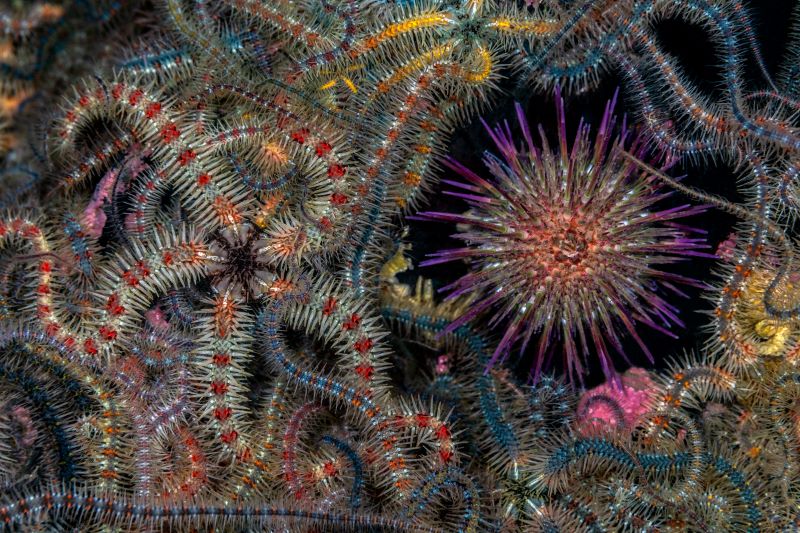
Photo: Jenny Stock
In the same contest, Portuguese photographer, Nuno Sá, was named ‘Save Our Seas
Foundation’ Marine Conservation Photographer of the Year 2024, with his photo ‘Saving
Goliath’, taken in Portugal. Sá’s photo shows beachgoers trying to save a stranded sperm
whale. The picture gives us hope that people do care and want to help the oceans, but also
warns us that bigger changes are needed. “The whale had been struck by a ship and its fate
was sealed,” explains Sá. “An estimated 20,000 whales are killed every year, and many more
injured, after being struck by ships-and few people even realise that it happens.”
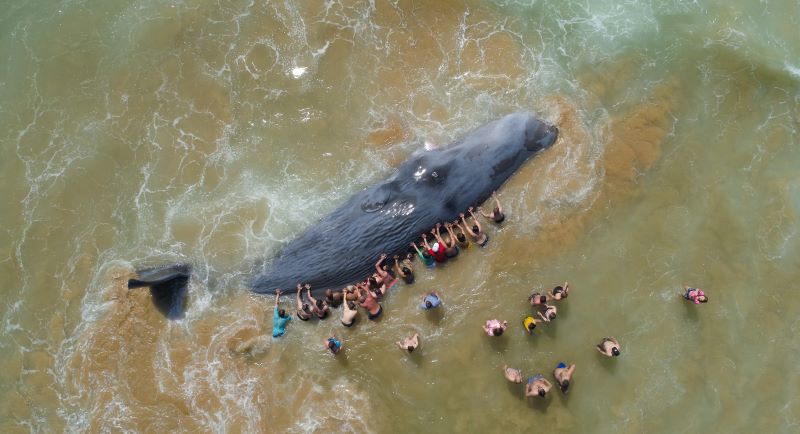
Photo: Nuno Sá
More winning images can be found at www.underwaterphotographeroftheyear.com.
About Underwater Photographer of the Year
Underwater Photographer of the Year is an annual competition, based in the UK, that celebrates photography beneath the surface of the ocean, lakes, rivers and even swimming pools, and attracts entries from all around the world. The contest has 13 categories, testing photographers with themes such as Macro, Wide Angle, Behaviour and Wreck photography, as well as four categories for photos taken specifically in British waters. The winners were announced in an award ceremony in Mayfair, London, hosted by The Crown Estate. This year’s UPY judges were experienced underwater photographers Peter Rowlands, Tobias Friedrich and Dr Alexander Mustard MBE.
Header image: Underwater Photographer of the Year 2024 winner Alex Dawson
News
World’s Best Underwater Photographers Unveil Breathtaking Images at World Shootout 2023
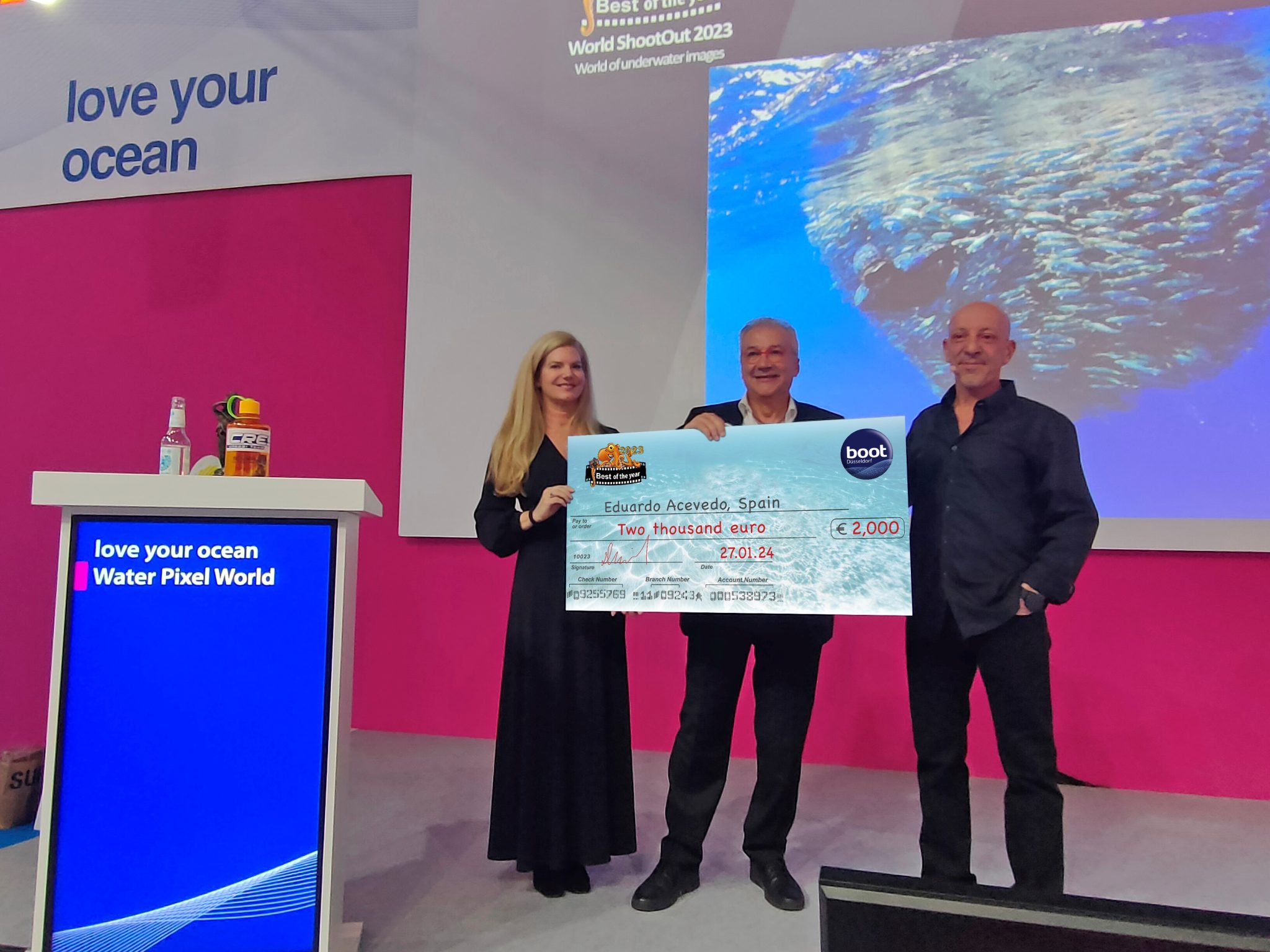
The winners of the prestigious World Shootout 2023 underwater photography competition were announced at this year’s BOOT Show, captivating audiences at the world’s largest diving and water sports exhibition in Dusseldorf, Germany. Hundreds of photographers from 54 countries competed across nine categories, pushing the boundaries of creativity and technical skill.
Grand Prize Winners
- Picture of the Year: Spanish photographer Eduardo Acevedo “secured” the top Honor with the prestigious prize the “boot Dusseldorf Director’s Prize, earning an Andromeda statuette and a €2,000 cash prize.
- Best 5 Images Portfolio: Luc Rooman from Belgium triumphed in this category, winning a dream 4-week diving trip for two to Papua New Guinea, valued at $18,900.
- Amateur Photographer: Alexandra Ceurvorst from the USA impressed the judges with her talent, taking home the 1,000 € cash prize award.
Celebrating Diversity and Innovation
This year’s competition saw 11,680 entries from 964 photographers, showcasing a remarkable spectrum of skills and perspectives. From the intricate wonders of Macro photography to the beauty of “Black Water”, the “Underwater Fashion” category added a touch of artistry and innovation, while the ever-important ” Environmental & Conservation” category served as a powerful reminder of the need to protect these fragile ecosystems.
Looking Ahead: AI and Ocean Conservation
World Shootout founder and producer David Pilosof unveiled an exciting addition for the 2024 competition: this year the Environmental category will be focusing on the impact of plastic on our oceans and future.
This category will embrace the potential of AI or other editing software as a tool to amplify the conservation message.
Entrants will submit campaigns of three original underwater photographs dealing with plastic pollution, along with their final AI assistance processing. This innovative approach encourages artistic expression while raising awareness about a critical environmental issue.
Explore the Stunning Collection
Discover the complete album of competition entries by clicking here.
For Low-resolution photos of finalist entries in eight categories, click here.
-

 News3 months ago
News3 months agoHone your underwater photography skills with Alphamarine Photography at Red Sea Diving Safari in March
-

 News2 months ago
News2 months agoCapturing Critters in Lembeh Underwater Photography Workshop 2024: Event Roundup
-

 Marine Life & Conservation Blogs2 months ago
Marine Life & Conservation Blogs2 months agoCreature Feature: Swell Sharks
-

 Blogs1 month ago
Blogs1 month agoMurex Resorts: Passport to Paradise!
-

 Gear News3 months ago
Gear News3 months agoBare X-Mission Drysuit: Ideal for Both Technical and Recreational Divers
-

 Blogs2 months ago
Blogs2 months agoDiver Discovering Whale Skeletons Beneath Ice Judged World’s Best Underwater Photograph
-

 Gear Reviews2 months ago
Gear Reviews2 months agoGear Review: Oceanic+ Dive Housing for iPhone
-
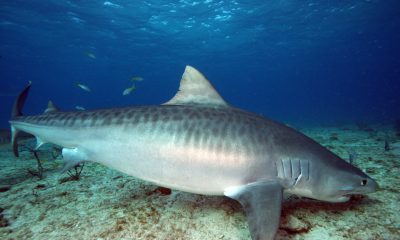
 Blogs3 months ago
Blogs3 months agoThe Thrilling Encounter with Tiger Sharks at Beqa Lagoon’s ‘The Colosseum’ with Coral Coast Divers










